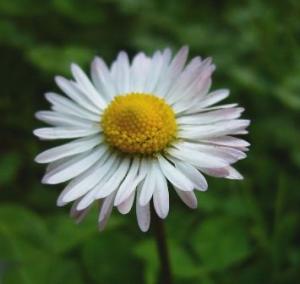Ground Apple

Anthemis nobilis, also known as Roman Chamomile, is a sweet smelling member of the sunflower family. The plant is also an important raw ingredient in the production of the herbal product known as chamomile. This bushy annual also produces very attractive yellow disk flowers about three-quarters to one inch in diameter that are surrounded by 12 to 20 silver-white ray flowers. The mature plant stands 8 to 12 inches tall with erect, branching hairless stems. The plant grows from a tap root and an extensive, fibrous root system that grows near the soil's surface.
The plant should be considered toxic for pets as it contains a variety of potentially harmful substances. The toxicity rating, however, is low as animals that either ingest or come into contact with the plant are much more likely to suffer irritant, not lethal consequences. The plant contains irritant substances the affect the skin and mucous membranes of grazing livestock, providing near immediate aggravation that tends to dissuade animals from ingesting any more of the plant. Additionally due to the plants strong odor and acrid taste most livestock avoid it unless no other food source is available.
Avoid further ingestion of the plant and consult a veterinarian. Outside of an allergic reaction, there is probably little chance that a dog or cat would suffer potentially serious consequences from a onetime ingestion of a moderate amount of the plant. Additionally the strong smell of the plant combined with is acrid taste make it very unlikely that a dog or cat would ingest enough of the plant or on a consistent enough basis to suffer serious consequences. As a result the extent of symptoms for a dog or cat would likely be limited oral irritation/ inflammation and/or gastrointestinal upset (mild vomiting, diarrhea) from eating or attempting to ingest the plant. In regards to a specific treatment regimen, common sense symptomatic care will probably be all that is required. If the ingestion was recent remove any existing plant matter from the mouth and flush thoroughly with water. If vomiting does not occur it may be induced by giving and emetic such as 3% hydrogen peroxide orally at a dose rate of 1 teaspoon per 10 lbs of body weight. The pet will more than likely start vomiting spontaneously without the help of an emetic, as their body tries to expel this non digestible material. The universal antidote, activated medical charcoal may also prove to be of some use in absorbing the toxins.
In the event that a dog or cat is suffering gastrointestinal upset as a result of ingesting this plant, ensure the pet gets plenty of fluids to avoid possible dehydration caused by diarrhea. To alleviate the gastrointestinal upset and diarrhea; Kapectolin may be given at a dose rate of 1 to 2 ml/kg four times a day. Kapectolin provides a coating action that protects the stomach lining. Sucralfate may also be used as for gastrointestinal irritation as it reacts with the acids in the stomach to form a paste-like material capable of acting as a barrier between the stomach and its contents. Sucralfate is typically given to dogs weighing more the 60lbs: 1g every 6 to 8 hours; for dogs under 60 lbs: 0.5g every 6 to 8 hours; Cats: 0.25g every 8 to 12 hours to reduce irritation of the stomach and intestines. The prognosis is good and the pet should make a full recovery within a 1 to 24 hours.
For grazing animals ensure that they are provided with adequate sources of food as most will only eat this plant as a last resort. In the event that the plant is ingested, common sense symptomatic care will probably be all that is needed. Prevent further ingestion of the plant, flush mouth with water, consult a veterinarian.




